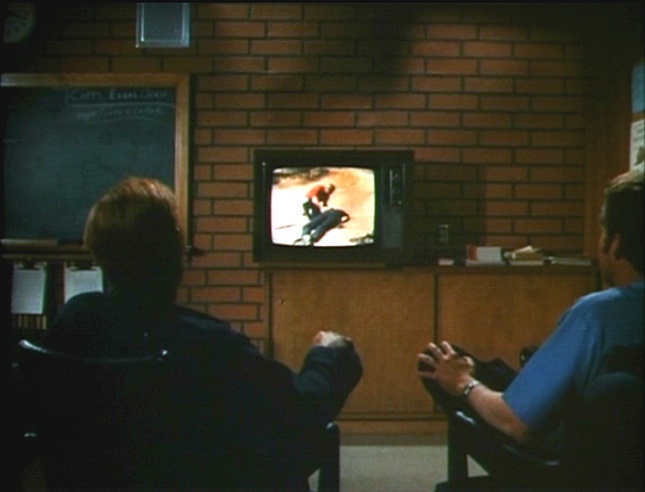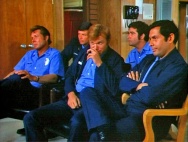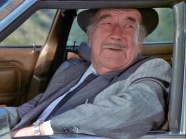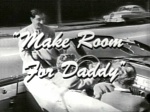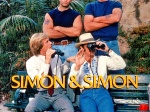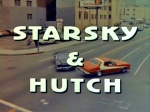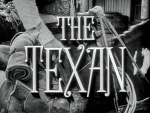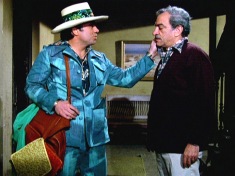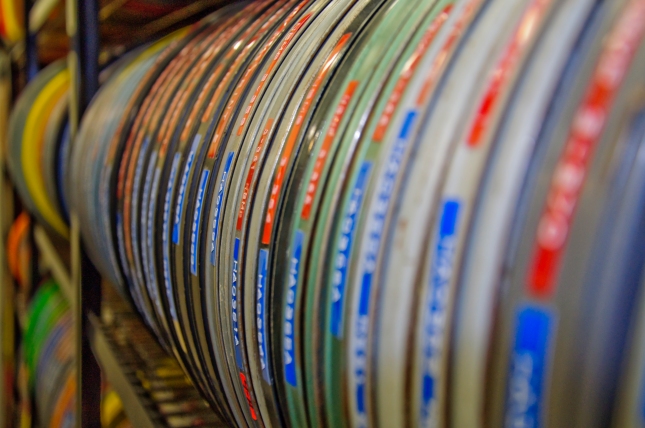 Long before home video, film buffs were collecting their favorite movies on 8mm or 16mm film. From the 1920s onward, various dealers popped up to offer little tin projectors and murky-looking prints of old cartoons and silent comedies.
Long before home video, film buffs were collecting their favorite movies on 8mm or 16mm film. From the 1920s onward, various dealers popped up to offer little tin projectors and murky-looking prints of old cartoons and silent comedies.
The variety and the quality got much better over the years, and by the 1960s-70s, film collecting was almost mainstream. Millions of middle-class families owned a reasonably good projector, a shoebox full of home movies, and maybe a few cartoons or “old-time” movies to keep the kids interested.
I got into the hobby myself at age 11 in 1976, buying Super 8mm prints of silent movies from the legendary Blackhawk Films. My mania for vintage TV didn’t emerge until many years later.
By then, film collecting had gone through a near-death experience. Around 1980 a spike in the price of silver drove prices sky-high, and many collectors drifted away to video discs and VHS machines. We die-hards carried on, buying and selling our prints through ads in collector papers like The Big Reel and Film Collectors World.
Brand-new film prints became harder to find. But by then, there were tens of thousands— in fact, probably hundreds of thousands of prints in circulation. All of us found some real treasures over the years.

The lair of a typical film collector.
Among film buffs, there’s a very common bias against anything produced for television. The golden age of Hollywood has a mystique that television has never been able to share. The typical film collector might specialize in silent comedies, or in talkie B-westerns or whatever. But relatively few collectors have much interest in vintage television, even though the TV stuff can be just as entertaining and fascinating as the movies, if not more so.
I have an old friend from the San Diego area who shared some of his collecting adventures for this blog. He’s one of the few film buffs I know who never considered television to be second-class entertainment. He prefers to remain anonymous, so we’ll just call him “George Lugner” (a name producer Mark Goodson once used when he guested on his own show, I’ve Got a Secret).
The stories you are about to hear are true. The names have been changed to protect the innocent… and the not-so-innocent.
………………………………………………………………………
Q: How and when did you get into film collecting?
Lugner: I bought my first Super 8mm prints about 1968. In those days, you could go to Sears and buy little condensations of 1950s science fiction movies, so it was easy. Besides classic comedy, my focus has always been on horror, science fiction and fantasy. I made the jump to 16mm in 1972 or ’73— the quality was so much better with 16mm, but 16mm was a lot more expensive— and a year or two after that, I began collecting my all-time favorite TV show, The Adventures of Superman with George Reeves. Harley Jeske had Superman dupes for fifty or sixty bucks each. Then I started networking with other film collectors, they connected me with their contacts, and I was on my way.
Q: How many of those Supermans did you have by the time I met you, in 1981 or ’82?
Lugner: Twenty of thirty. It took a lot of time, and a lot of looking, but eventually I got them all. And along the way, I was upgrading. If I had a dupe of an episode and an original came along, I’d buy the original and sell off the dupe.
Q: I met you at Sean Rock’s house in San Diego. He was a big film buff. Besides having theater chairs and a huge outdoor screen in his backyard, he’d turned his living room into a screening room, with a separate projection booth. I’d never seen TV shows on film, projected onto a screen, until then. The difference between seeing them that way, versus on a little TV set between commercial breaks, was like night and day.
Lugner: Some of the prints we showed were mine. But Sean and his crowd were mostly into movies. I’d put a terrific first-season episode of Superman on the screen and the room would almost empty out.
Q: They’d all salivate over a two-reel short subject. But a 25-minute movie made for TV? Forget it.
Lugner: Right.
Q: I still got to see a few great TV things on the big screen there. I remember a good one was an episode of a 1950s anthology show, and it had Bert Lahr and Margaret Hamilton from The Wizard of Oz in it.
Lugner: Right, Bert Lahr discovers a gold mine in the New York City subway system and Hamilton plays his wife. I don’t remember what series that was from. (Editor’s note: It was a very obscure show, Rendezvous (1:12, “A Very Fine Deal,” December 6, 1958).)

The murderous wax figures of “The New Exhibit.” That one in the middle gave me a few sleepless nights.
Q: One of you guys brought in a print of the first hour-long Twilight Zone I’d ever seen (4:13, “The New Exhibit,” April 4, 1963). I remember being very creeped out by it, seeing it in the dark on the big screen in Sean’s living room. To this day, it’s the only Twilight Zone that ever really got to me.
Lugner: That was mine, another print that I picked up and then traded away— or sold away. I also showed another one of those at Sean’s, “He’s Alive” with Dennis Hopper.
Q: Tell me about other TV show prints that passed through your hands over the years. I was mainly into silent movies in those days, but I remember you had stray episodes of shows I’d never heard of then, like M Squad.
Lugner: Most of it was things I didn’t necessarily want to keep forever, but I’d grab it to watch, and re-sell. I had the Three Stooges on Ed Wynn, an original (1:25, March 11, 1950). I had pilots for Get Smart— the 25-minute syndicated version, and the unaired 30-minute pilot.
Q: I still remember when you ran that for us at your parents’ place. I’m not a huge Get Smart fan, but that pilot was great.
Lugner: I had pilots for Land of the Giants, Lost in Space (with and without Dr. Smith)… all of this is out on Blu-Ray now, but in those days it was all unseen and forgotten. I had the Batman pilot. I had a gorgeous print of the Star Trek “Trouble with Tribbles,” which I ran at one of the early comic conventions for a standing-room-only crowd. None of them had ever seen the original Star Trek up on a movie screen, and it went over like gangbusters, people laughing and applauding and enjoying it all together as one big audience. That sort of thing eventually stopped. They stopped using collector prints at shows like that.
 Q: I remember you had those little fillers with Korla Pandit playing the organ.
Q: I remember you had those little fillers with Korla Pandit playing the organ.
Lugner: Yeah, those all ran fifteen minutes or so. They were made so that TV stations would have something to fill out the hour with, when a movie ran short. They couldn’t just run commercials for ten or fifteen minutes straight, so they’d run these Korla Pandit things. At one time I had thirty or forty. I think I still have a couple of them. Those came from a collector whose niece was selling them off really cheap.
Q: I remember watching those with you in your parents’ garage. He kept looking up from his keyboard with a mysterious smile and then looking down again.
Lugner: At one time I had this reel that was nothing but openings, closings and commercials from The Abbott and Costello Show, where they were pushing Chunky candy bars. I knew a guy who really collected Abbott and Costello, so I called him and let him know it was available. I asked for $500, and instantly he says “Sold!” I felt great. Then he tells me he would’ve offered me two grand for it.
Q: I don’t think the DVDs of that show have the original closings on them.
Lugner: No. Once I had an episode of The Felony Squad with Russell Johnson in it. He played an arsonist (2:26, “The Human Target,” March 18, 1968). I knew that he was going to be appearing at a convention that was coming up, so I film-chained it and made a VHS copy. I gave it to him and he was ecstatic, which was nice.
Q: How about kinescopes? Did you ever run across very many of those?
Lugner: Now and then. I probably had some one-of-a-kind kinescopes to shows you’ll never see again. One had Dick York from Bewitched, one of those shows they did live on the air. I think it was a cop show. There was one shot where there’s a guy on a gurney, and they wheel him in and they bump the wall, which shakes like it’s about to fall over. I’m trying to remember the title. (Editor’s note: This may have been Eye on New York (“Night of the Auk,” December 1, 1956).) I had a couple Colgate Comedy Hours with commercials. I had a Jackie Gleason Show with a live Honeymooners sketch in it, and commercials of Jackie pushing products.
Q: Tell me about that package of Felix the Cat cartoons. Somewhere around 1985 or 1986 you suddenly had a ton of Felix cartoons from the 1920s, which had been released to television in the ‘50s. I bought a bunch of those from you.
Lugner: Well, there was a guy named Mack Plummer, who’s still around. He called me one time and offered me complete runs of three or four shows I wanted: every episode of each. I said okay and wrote him a check. He came back saying there was a delay and that he needed more money. I wrote another check. He never did come up with the prints. What happened was, he was involved in a video store that was in trouble and he spent my money trying to save this store. So I started talking mail fraud if he couldn’t make good on what he owed me, or at least make an effort. In the end I was only able to get this package of Felix cartoons. In the ‘50s someone turned up these silent Felixes, and slapped soundtracks on them: just tinkly piano music and occasionally a guy going “Me-wowwww,” you know. And independent stations would run them. I had about fifty of them. A few were still silent for some reason, and there were some duplicates here and there.
Q: There are a lot of eccentric collectors and dealers. You told me about this one guy who’s a major TV collector and his house is full of stacks of boxes of film reels, including stuff he’d get in the mail and then never open.
Lugner: He’s still around. He’s ticked off every person he’s ever come in contact with. He was involved in one of the annual film conventions until he alienated everybody there. When I met him, he was living with his elderly mother, who couldn’t have been sweeter, and he would talk down to her. After she died, he inherited the house and it became the dumping ground for his film collection. Film everywhere. In his room was just a cot, a table with rewinds, and big racks of films. He used to make good money selling trailers and clips to things like Entertainment Tonight, but when the internet came in, it killed off that business.
Q: Wow.
Lugner: There was another guy who’d rent films from Universal 16. He’d keep the prints and mail back a box with bricks in it. He never got in trouble for it; he’d just play dumb.
Q: There were guys who’d get film prints from TV stations.
Lugner: Well, until around twenty years ago, anytime you saw a movie or a syndication TV show on your local station, you were seeing a 16mm film print. A station would lease a package of prints of old movies (or they’d lease an old TV series) for five years, with an option to renew. If the station didn’t want to pay to renew that lease, they could either destroy the films and mail in a form, saying the films were destroyed… or they could box up all those prints and mail them back to Bonded. Well, if you’re some guy working at the TV station, you know it’s a lot easier to just carry the prints out to the dumpster and be done with it.
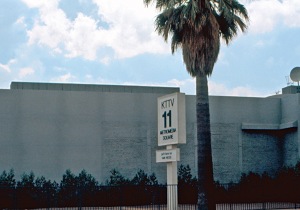
I’m sure they lock the dumpsters now.
Q: I remember hearing about a collector who found an entire run of I Love Lucy in a dumpster, and loaded up his car with Lucys.
Lugner: Yeah, there was a guy in L.A. who’d drive over to Channel 11 and check their dumpster every week on the day before trash day. Eventually he hit the jackpot and there was a whole run of I Love Lucy, still in the yellow Viacom cans. Another time, Channel 51 in San Diego threw out their entire film collection. My friends Matt and Ross were working close to the station, and they heard about it, so they went over there on their lunch break and just loaded up their cars.
Q: I remember that.
Lugner: And the equipment got junked too. These expensive machines that would run the films and send them out over the air…. they were just sitting there in the rain. The real heartbreaker was Channel 6. I knew they had a ton of film, and I knew that eventually it would all go in the trash. And I knew a guy who worked there. I’d call him every few months to touch base and let him know I’d make it worth his while, if he’d tell me when it was time to dump the prints. And then one day they threw out all the prints, and the guy never told me.
Q: And throughout all of these years, you were steadily working on your Adventures of Superman collection.
Lugner: I was looking for episodes from the mid-’70s all the way until the mid-‘90s. I finally got every one of them, all 104 episodes.
Q: I remember a lot of them had the original bumpers at the commercial breaks— “The Adventures of Superman will continue in just a moment!”
Lugner: The down side of collecting on film is that the color can start to go red. You can pick up scratches. The print can turn vinegar. When I discovered that some of the color prints were just beginning to turn warm, I began selling them off. I got as much money for the bad ones as I did for the good ones. I don’t have many Supermans left now.
Q: And besides all the episodes, you had pilots for Superboy and Superpup.
 Lugner: My prize was “Stamp Day for Superman,” which was a special short made by the government where Superman tells everybody to buy savings bonds. Dupes were all over the place, but I wanted an original. Finally I met a guy who had one, which he’d personally bought direct from the U.S. Treasury for about two hundred dollars. (There was a time when you could buy things like that from the Treasury, like Abbott and Costello pitching savings bonds.) It was almost pristine mint. I’ve never found another original. So that was my prize. I even sent it to a film lab to have it coated, to treat it. But then the print couldn’t breathe, and it turned vinegar. Finally the vinegar was so bad that it couldn’t be projected anymore. But I kept it for another two or three years anyway! Finally I threw it out and didn’t look back. All of that took the wind out of my sails as far as film collecting went. That was about 2007.
Lugner: My prize was “Stamp Day for Superman,” which was a special short made by the government where Superman tells everybody to buy savings bonds. Dupes were all over the place, but I wanted an original. Finally I met a guy who had one, which he’d personally bought direct from the U.S. Treasury for about two hundred dollars. (There was a time when you could buy things like that from the Treasury, like Abbott and Costello pitching savings bonds.) It was almost pristine mint. I’ve never found another original. So that was my prize. I even sent it to a film lab to have it coated, to treat it. But then the print couldn’t breathe, and it turned vinegar. Finally the vinegar was so bad that it couldn’t be projected anymore. But I kept it for another two or three years anyway! Finally I threw it out and didn’t look back. All of that took the wind out of my sails as far as film collecting went. That was about 2007.
Q: I’ve sold 99% of my 16mm. It’s still the golden age of collecting, but video just makes way more sense than film.
Lugner: There’s still no substitute for the way film looks, projected on a big screen. But yeah.
Q: Tell me about the “Warehouse O’ Film.” I’ve been hearing about that place for years, but only in bits and pieces.
Lugner: Jay Masterson had this warehouse. I knew collectors who shopped there, but they kept it a secret from me. It was the promised land for film collectors. Finally I happened to meet the guy at the Ray Courts show. (Editor’s note: this was the forerunner of the Hollywood collectors’ shows, at which dealers sell their goods and yesteryear’s celebrities sell signed photos.) He handed me a flyer and I went up there the next week.
Q: When and where was this?
Lugner: Mid-‘80s. In Burbank, he had a warehouse. Just big gorilla racks, piled floor to ceiling with pallets of film. Boxes of film everyplace. New lab prints. Well, nearly new. Everything was priced very reasonably. Movies, cartoons, TV— cartoons were five dollars each— he just wanted to get things out of there and he had new stuff arriving on a regular basis.
Q: He had complete runs of various TV series?
Lugner: Maybe every TV series you’d see in syndication was there. He had TV shows for about twenty bucks in the box, but Supermans were fifty. Most of the color prints looked pristine because Warners had done some restoration on those. Some of the Batmans he sold were red but they were in good shape otherwise. He had original Bilkos, still in their boxes, and over time I bought about fifty of them. F Troop… you name it. Bryce Schwab would buy complete runs of Batman, Time Tunnel, Lost in Space, The Green Hornet and so on. Mint low-fades.
Q: But how did Jay get all of this film in the first place?
Lugner: He got them from Bonded Film Services. They originally came from the studios— the labs— and they’d go out to TV stations. Then when the leases expired, the stations would either destroy them (or toss them out and say they were destroyed), or they’d get sent back to Bonded.
Q: But how did Jay get them?
Lugner: If the prints came back to Bonded and they were considered too old to keep in circulation, Bonded didn’t want them anymore. It would embarrass the stations to run something with a splice or a scratch in it, so Bonded figured that when the print had gone through the equipment so many times, its working life was over and it needed to be retired. Now there’s a trace amount of silver in film. That’s where Jay comes in. He would pick up a load of film, sign something saying he was going to reclaim the silver, and now he’s got all these prints.
Q: I see.
Lugner: I think he told me he was paying them about $1.10 per fifty pounds of film. So officially, his warehouse is full of stuff for silver reclamation. But if you come in and you’ve got cash in your pocket, he’ll make you a deal.
Q: Now I get it.
Lugner: He was a great guy. Most of the collectors called him Jabba, like Jabba the Hutt, because he weighed about four hundred pounds. He’d sit behind his desk, give orders to a couple of Mexican guys working for him, and they’d go pull prints for you. But if he knew you were looking for something in particular, he’d tell you he had it, and then he’d charge you twice as much for it. But it would still be cheap. Behind his desk was what he called the “gems.” For example, mint Star Treks for fifty bucks each, which I would later on sell for $200 or $300 each.
Q: And you made a living selling film prints, basically.
Lugner: This was before the internet. If I knew then what I know now, I’d have borrowed every nickel I could find and I’d have bought as much stuff as I could get, which would have been a lot! Film collecting is mostly on the internet now. The big collectors are on eBay— there’s a big Bewitched collector. There’s a Lucy collector, who’s sold almost all of his prints by now…
Q: So whatever happened to the “Warehouse O’ Film”?
Lugner: The Northridge earthquake hit and damaged the warehouse. He said “Screw it,” closed up shop, moved to Vegas and died on his toilet. Like Elvis.
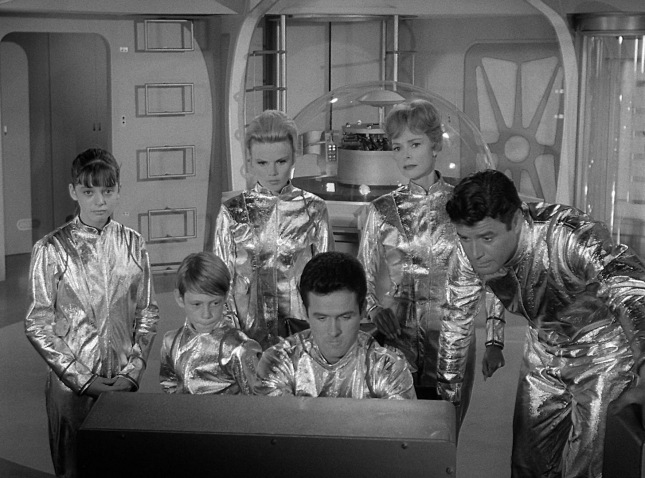
The Lost in Space pilot. Penny knows that a little picture tube can’t compare to the big screen.
 A lot of us grew up watching the 1967-1970 revival of Dragnet, either first-run or in syndication. It’s known informally as “the color Dragnet,” to differentiate it from the black-and-white original, which aired from 1951 to 1959. Both incarnations were NBC shows. (Radio buffs will scowl and remind you that the true original Dragnet was the radio series, and they’re right, but let’s stick to TV.)
A lot of us grew up watching the 1967-1970 revival of Dragnet, either first-run or in syndication. It’s known informally as “the color Dragnet,” to differentiate it from the black-and-white original, which aired from 1951 to 1959. Both incarnations were NBC shows. (Radio buffs will scowl and remind you that the true original Dragnet was the radio series, and they’re right, but let’s stick to TV.)
























